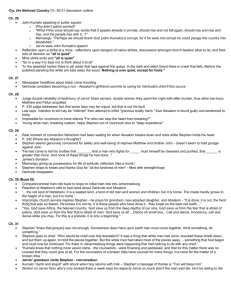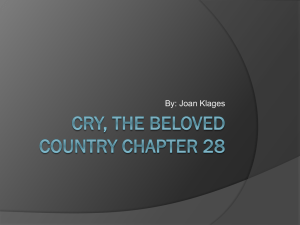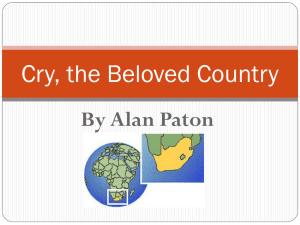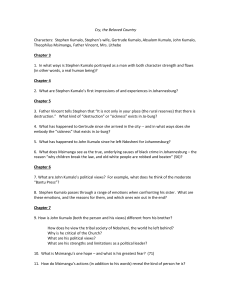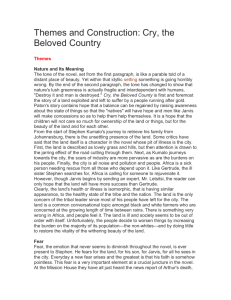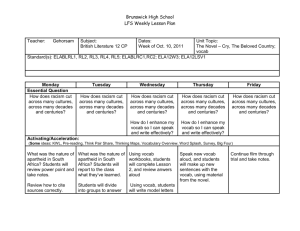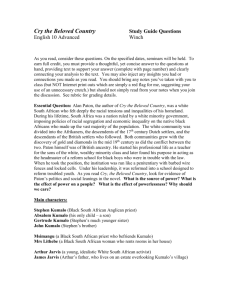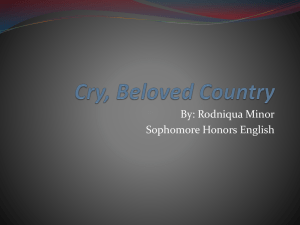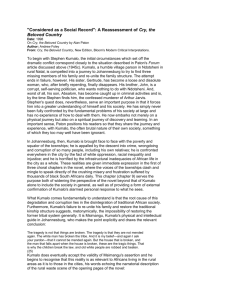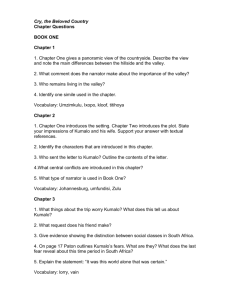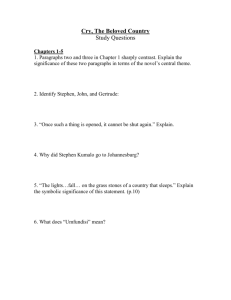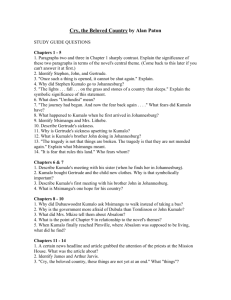Cry the Beloved Country Themes
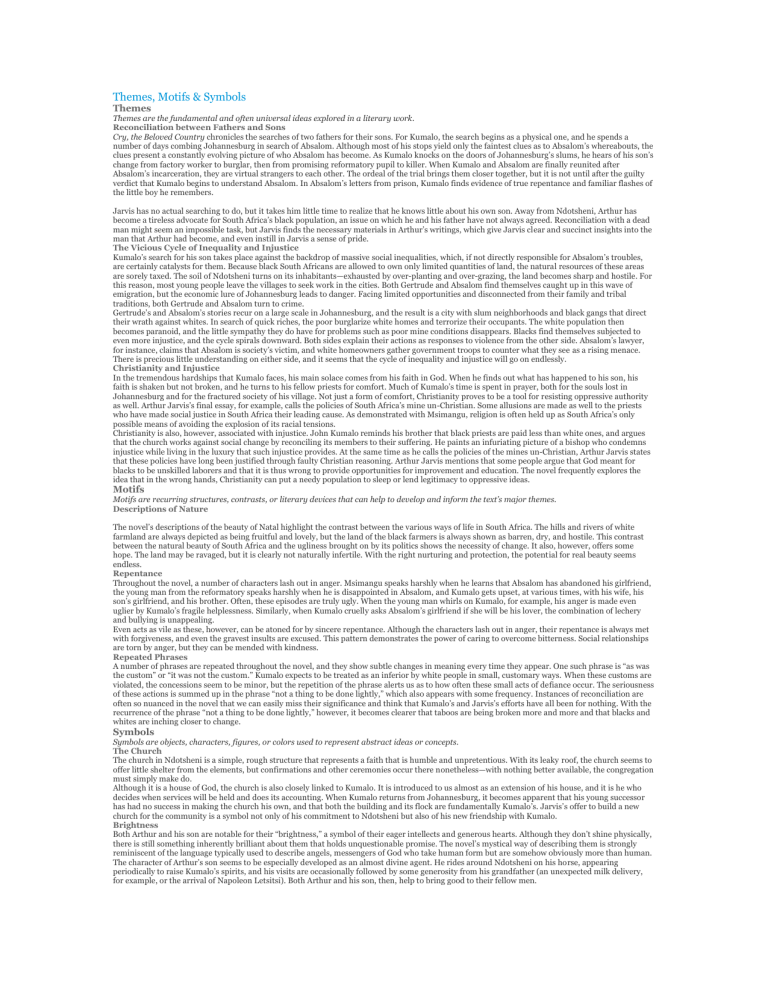
Themes, Motifs & Symbols
Themes
Themes are the fundamental and often universal ideas explored in a literary work.
Reconciliation between Fathers and Sons
Cry, the Beloved Country chronicles the searches of two fathers for their sons. For Kumalo, the search begins as a physical one, and he spends a number of days combing Johannesburg in search of Absalom. Although most of his stops yield only the faintest clues as to Absalom’s whereabouts, the clues present a constantly evolving picture of who Absalom has become. As Kumalo knocks on the doors of Johannesburg’s slums, he hears of his son’s change from factory worker to burglar, then from promising reformatory pupil to killer. When Kumalo and Absalom are finally reunited after
Absalom’s incarceration, they are virtual strangers to each other. The ordeal of the trial brings them closer together, but it is not until after the guilty verdict that Kumalo begins to understand Absalom. In Absalom’s letters from prison, Kumalo finds evidence of true repentance and familiar flashes of the little boy he remembers.
Jarvis has no actual searching to do, but it takes him little time to realize that he knows little about his own son. Away from Ndotsheni, Arthur has become a tireless advocate for South Africa’s black population, an issue on which he and his father have not always agreed. Reconciliation with a dead man might seem an impossible task, but Jarvis finds the necessary materials in Arthur’s writings, which give Jarvis clear and succinct insights into the man that Arthur had become, and even instill in Jarvis a sense of pride.
The Vicious Cycle of Inequality and Injustice
Kumalo’s search for his son takes place against the backdrop of massive social inequalities, which, if not directly responsible for Absalom’s troubles, are certainly catalysts for them. Because black South Africans are allowed to own only limited quantities of land, the natural resources of these areas are sorely taxed. The soil of Ndotsheni turns on its inhabitants—exhausted by over-planting and over-grazing, the land becomes sharp and hostile. For this reason, most young people leave the villages to seek work in the cities. Both Gertrude and Absalom find themselves caught up in this wave of emigration, but the economic lure of Johannesburg leads to danger. Facing limited opportunities and disconnected from their family and tribal traditions, both Gertrude and Absalom turn to crime.
Gertrude’s and Absalom’s stories recur on a large scale in Johannesburg, and the result is a city with slum neighborhoods and black gangs that direct their wrath against whites. In search of quick riches, the poor burglarize white homes and terrorize their occupants. The white population then becomes paranoid, and the little sympathy they do have for problems such as poor mine conditions disappears. Blacks find themselves subjected to even more injustice, and the cycle spirals downward. Both sides explain their actions as responses to violence from the other side. Absalom’s lawyer, for instance, claims that Absalom is society’s victim, and white homeowners gather government troops to counter what they see as a rising menace.
There is precious little understanding on either side, and it seems that the cycle of inequality and injustice will go on endlessly.
Christianity and Injustice
In the tremendous hardships that Kumalo faces, his main solace comes from his faith in God. When he finds out what has happened to his son, his faith is shaken but not broken, and he turns to his fellow priests for comfort. Much of Kumalo’s time is spent in prayer, both for the souls lost in
Johannesburg and for the fractured society of his village. Not just a form of comfort, Christianity proves to be a tool for resisting oppressive authority as well. Arthur Jarvis’s final essay, for example, calls the policies of South Africa’s mine un-Christian. Some allusions are made as well to the priests who have made social justice in South Africa their leading cause. As demonstrated with Msimangu, religion is often held up as South Africa’s only possible means of avoiding the explosion of its racial tensions.
Christianity is also, however, associated with injustice. John Kumalo reminds his brother that black priests are paid less than white ones, and argues that the church works against social change by reconciling its members to their suffering. He paints an infuriating picture of a bishop who condemns injustice while living in the luxury that such injustice provides. At the same time as he calls the policies of the mines un-Christian, Arthur Jarvis states that these policies have long been justified through faulty Christian reasoning. Arthur Jarvis mentions that some people argue that God meant for blacks to be unskilled laborers and that it is thus wrong to provide opportunities for improvement and education. The novel frequently explores the idea that in the wrong hands, Christianity can put a needy population to sleep or lend legitimacy to oppressive ideas.
Motifs
Motifs are recurring structures, contrasts, or literary devices that can help to develop and inform the text’s major themes.
Descriptions of Nature
The novel’s descriptions of the beauty of Natal highlight the contrast between the various ways of life in South Africa. The hills and rivers of white farmland are always depicted as being fruitful and lovely, but the land of the black farmers is always shown as barren, dry, and hostile. This contrast between the natural beauty of South Africa and the ugliness brought on by its politics shows the necessity of change. It also, however, offers some hope. The land may be ravaged, but it is clearly not naturally infertile. With the right nurturing and protection, the potential for real beauty seems endless.
Repentance
Throughout the novel, a number of characters lash out in anger. Msimangu speaks harshly when he learns that Absalom has abandoned his girlfriend, the young man from the reformatory speaks harshly when he is disappointed in Absalom, and Kumalo gets upset, at various times, with his wife, his son’s girlfriend, and his brother. Often, these episodes are truly ugly. When the young man whirls on Kumalo, for example, his anger is made even uglier by Kumalo’s fragile helplessness. Similarly, when Kumalo cruelly asks Absalom’s girlfriend if she will be his lover, the combination of lechery and bullying is unappealing.
Even acts as vile as these, however, can be atoned for by sincere repentance. Although the characters lash out in anger, their repentance is always met with forgiveness, and even the gravest insults are excused. This pattern demonstrates the power of caring to overcome bitterness. Social relationships are torn by anger, but they can be mended with kindness.
Repeated Phrases
A number of phrases are repeated throughout the novel, and they show subtle changes in meaning every time they appear. One such phrase is “as was the custom” or “it was not the custom.” Kumalo expects to be treated as an inferior by white people in small, customary ways. When these customs are violated, the concessions seem to be minor, but the repetition of the phrase alerts us as to how often these small acts of defiance occur. The seriousness of these actions is summed up in the phrase “not a thing to be done lightly,” which also appears with some frequency. Instances of reconciliation are often so nuanced in the novel that we can easily miss their significance and think that Kumalo’s and Jarvis’s efforts have all been for nothing. With the recurrence of the phrase “not a thing to be done lightly,” however, it becomes clearer that taboos are being broken more and more and that blacks and whites are inching closer to change.
Symbols
Symbols are objects, characters, figures, or colors used to represent abstract ideas or concepts.
The Church
The church in Ndotsheni is a simple, rough structure that represents a faith that is humble and unpretentious. With its leaky roof, the church seems to offer little shelter from the elements, but confirmations and other ceremonies occur there nonetheless—with nothing better available, the congregation must simply make do.
Although it is a house of God, the church is also closely linked to Kumalo. It is introduced to us almost as an extension of his house, and it is he who decides when services will be held and does its accounting. When Kumalo returns from Johannesburg, it becomes apparent that his young successor has had no success in making the church his own, and that both the building and its flock are fundamentally Kumalo’s. Jarvis’s offer to build a new church for the community is a symbol not only of his commitment to Ndotsheni but also of his new friendship with Kumalo.
Brightness
Both Arthur and his son are notable for their “brightness,” a symbol of their eager intellects and generous hearts. Although they don’t shine physically, there is still something inherently brilliant about them that holds unquestionable promise. The novel’s mystical way of describing them is strongly reminiscent of the language typically used to describe angels, messengers of God who take human form but are somehow obviously more than human.
The character of Arthur’s son seems to be especially developed as an almost divine agent. He rides around Ndotsheni on his horse, appearing periodically to raise Kumalo’s spirits, and his visits are occasionally followed by some generosity from his grandfather (an unexpected milk delivery, for example, or the arrival of Napoleon Letsitsi). Both Arthur and his son, then, help to bring good to their fellow men.
